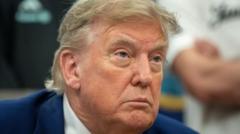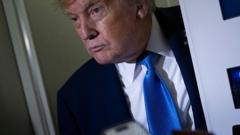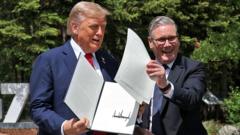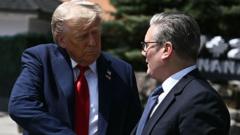Analysts warn of higher prices and uncertainty as automakers adapt to sweeping tariff changes.
US Implements 25% Tariff on Auto Parts Amid Industry Turmoil

US Implements 25% Tariff on Auto Parts Amid Industry Turmoil
The new tariff aims to boost domestic manufacturing at a cost to global production and consumer prices.
The United States has officially enacted a 25% import tax on essential automotive components like engines and transmissions, intensifying challenges for an industry already navigating a complex landscape of regulatory changes. This move comes shortly after former President Donald Trump dialed back similar measures in response to industry concerns but ultimately maintained the tariffs.
Trump stated that these tariffs, coupled with a 25% tax on cars introduced last month, are mainly directed at motivating carmakers to increase their manufacturing footprint in the US. Analysts, however, predict that immediate expansions in the US automotive sector are likely to compromise production in other countries, resulting in increased operational costs and, subsequently, higher retail prices for consumers. Despite this looming threat, current sales figures have seen a boost, with major players like General Motors (GM) and Ford reporting significant growth in April sales.
Yet, GM has already cautioned that it may incur as much as $5 billion in additional costs this year due to these tariffs, including approximately $2 billion on vehicles manufactured in South Korea for the US market. Executives at the company now foresee a price increase of around 1%, a stark contrast to earlier predictions of falling prices.
The turbulence within the automotive sector has prompted several companies, including Stellantis—maker of Jeep and Chrysler—to retract their financial guidance for the upcoming year, citing the unpredictable nature of the new economic environment. Stellantis Chief Financial Officer Doug Ostermann lamented that the industry remains "subject to extreme uncertainties."
In 2022, nearly half of the vehicles sold in the US were imported, underscoring the significant impact of Trump’s tariff announcement in March, which sent shockwaves throughout the industry and sparked fears of escalating prices, production disruptions, and diminished sales potential.
While the former president has softened some tariff measures on Canada and Mexico—critical players in the supply chain—certain parts made in these countries that comply with existing trade agreements will remain exempt from duties. Initially viewed as a temporary reprieve, analysts now suggest this exemption may become permanent based on recent customs guidelines.
Additionally, this week, Trump signed legislation aimed at preventing companies from facing multiple tariffs on the same product while implementing a two-year system to help manufacturers lower their part-related tariff burdens. Notably, firms bringing in cars constructed in Canada and Mexico that include US-made content will escape tariffs.
Despite the amelioration of some tariff impacts, experts maintain that the overall changes pose a significant adjustment to the market. Stephanie Brinley, principal automotive analyst at S&P Global Mobility, remarked, "It's still a big tariff" despite the administration's efforts to cushion the blow.
Executives in the automotive sector are now considering various strategies for domestic production growth to offset rising costs. For instance, GM announced a 50,000-increase in truck production at its Indiana plant, along with plans to scale back operations in Canada. Mercedes has also stated it has capacity to expand production at its Alabama facility.
Art Wheaton, director of Labor Studies at Cornell University, expressed skepticism about new factory establishments emerging quickly, given the substantial investment required and the current volatility of the market. "If I’m going to make a multi-billion dollar decision... I wouldn’t do it in a market that is this unstable," he warned.
The administration claims to be pursuing trade agreements with vital international partners, such as South Korea and Japan, but may reconsider its tariff policies if economic harm becomes evident. "Everything is pretty good now," Wheaton noted, "but I don’t think the full impact of those tariffs has hit yet."
Trump stated that these tariffs, coupled with a 25% tax on cars introduced last month, are mainly directed at motivating carmakers to increase their manufacturing footprint in the US. Analysts, however, predict that immediate expansions in the US automotive sector are likely to compromise production in other countries, resulting in increased operational costs and, subsequently, higher retail prices for consumers. Despite this looming threat, current sales figures have seen a boost, with major players like General Motors (GM) and Ford reporting significant growth in April sales.
Yet, GM has already cautioned that it may incur as much as $5 billion in additional costs this year due to these tariffs, including approximately $2 billion on vehicles manufactured in South Korea for the US market. Executives at the company now foresee a price increase of around 1%, a stark contrast to earlier predictions of falling prices.
The turbulence within the automotive sector has prompted several companies, including Stellantis—maker of Jeep and Chrysler—to retract their financial guidance for the upcoming year, citing the unpredictable nature of the new economic environment. Stellantis Chief Financial Officer Doug Ostermann lamented that the industry remains "subject to extreme uncertainties."
In 2022, nearly half of the vehicles sold in the US were imported, underscoring the significant impact of Trump’s tariff announcement in March, which sent shockwaves throughout the industry and sparked fears of escalating prices, production disruptions, and diminished sales potential.
While the former president has softened some tariff measures on Canada and Mexico—critical players in the supply chain—certain parts made in these countries that comply with existing trade agreements will remain exempt from duties. Initially viewed as a temporary reprieve, analysts now suggest this exemption may become permanent based on recent customs guidelines.
Additionally, this week, Trump signed legislation aimed at preventing companies from facing multiple tariffs on the same product while implementing a two-year system to help manufacturers lower their part-related tariff burdens. Notably, firms bringing in cars constructed in Canada and Mexico that include US-made content will escape tariffs.
Despite the amelioration of some tariff impacts, experts maintain that the overall changes pose a significant adjustment to the market. Stephanie Brinley, principal automotive analyst at S&P Global Mobility, remarked, "It's still a big tariff" despite the administration's efforts to cushion the blow.
Executives in the automotive sector are now considering various strategies for domestic production growth to offset rising costs. For instance, GM announced a 50,000-increase in truck production at its Indiana plant, along with plans to scale back operations in Canada. Mercedes has also stated it has capacity to expand production at its Alabama facility.
Art Wheaton, director of Labor Studies at Cornell University, expressed skepticism about new factory establishments emerging quickly, given the substantial investment required and the current volatility of the market. "If I’m going to make a multi-billion dollar decision... I wouldn’t do it in a market that is this unstable," he warned.
The administration claims to be pursuing trade agreements with vital international partners, such as South Korea and Japan, but may reconsider its tariff policies if economic harm becomes evident. "Everything is pretty good now," Wheaton noted, "but I don’t think the full impact of those tariffs has hit yet."




















